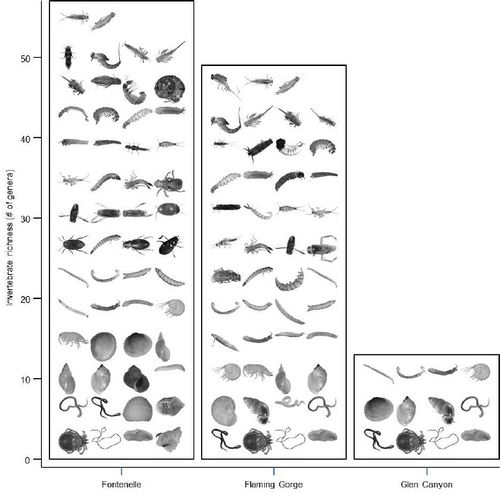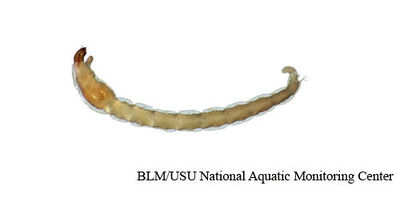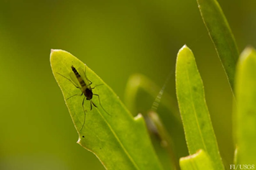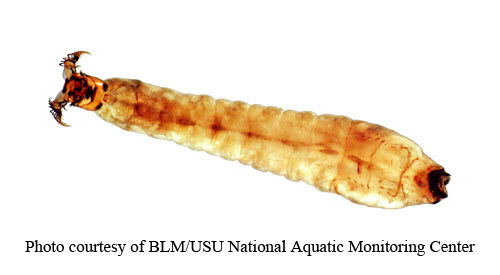Difference between revisions of "Aquatic Macroinvertebrates"
Cellsworth (Talk | contribs) |
Cellsworth (Talk | contribs) |
||
| Line 46: | Line 46: | ||
==Midges (Chironomidae)== | ==Midges (Chironomidae)== | ||
Midges are small, delicate flies, resembling mosquitoes but do not bite. Larvae are usually found in sediments, and can occur in everything ranging from highly polluted conditions to relatively clean water. [https://bugguide.net/node/view/3163] [http://www.chironomidae.net/index.html] The chironomid fauna of the Colorado River in Grand Canyon is depauperate in comparison with other western rivers (e.g., Sublette | Midges are small, delicate flies, resembling mosquitoes but do not bite. Larvae are usually found in sediments, and can occur in everything ranging from highly polluted conditions to relatively clean water. [https://bugguide.net/node/view/3163] [http://www.chironomidae.net/index.html] The chironomid fauna of the Colorado River in Grand Canyon is depauperate in comparison with other western rivers (e.g., Sublette | ||
| − | and Sublette 1979, Wolz and Shiozawa 1995, Spindler 1996). Our collections include 38 species in 23 genera and 4 subfamilies. The fauna is dominated by the Orthoeladiinae (23 species), with 5 abundant species: Cricotopus annulator > Cricotopus globistylus > Eukiefferiella claripennis > Orthocladius rivicola > Tvetenia vitracies. The fauna includes 12 Chironominae species, with Chironomtts spp. regularly found in low densities in pool and backwater habitats floored with fine sand or silt, and with Procladius bellus, Paracladius conversus, Chironornus decorus, C. sp. 1, and C. sp. 2 collected only in the ULM segment. [https://scholarsarchive.byu.edu/cgi/viewcontent.cgi?referer=https://www.google.com/&httpsredir=1&article=3242&context=gbn] | + | and Sublette 1979, Wolz and Shiozawa 1995, Spindler 1996). |
| + | |||
| + | Our collections include 38 species in 23 genera and 4 subfamilies. The fauna is dominated by the Orthoeladiinae (23 species), with 5 abundant species: Cricotopus annulator > Cricotopus globistylus > Eukiefferiella claripennis > Orthocladius rivicola > Tvetenia vitracies. The fauna includes 12 Chironominae species, with Chironomtts spp. regularly found in low densities in pool and backwater habitats floored with fine sand or silt, and with Procladius bellus, Paracladius conversus, Chironornus decorus, C. sp. 1, and C. sp. 2 collected only in the ULM segment. [https://scholarsarchive.byu.edu/cgi/viewcontent.cgi?referer=https://www.google.com/&httpsredir=1&article=3242&context=gbn] | ||
[[File:Midge.jpg|thumb|right|400px|Midge (larvae)]] [[File:Insect_leaf.png|thumb|right|400px|Midge (adult)]] | [[File:Midge.jpg|thumb|right|400px|Midge (larvae)]] [[File:Insect_leaf.png|thumb|right|400px|Midge (adult)]] | ||
| Line 52: | Line 54: | ||
====TANYPODINAE==== | ====TANYPODINAE==== | ||
| − | * | + | *Procladius bellus |
====DIAMESlNAE==== | ====DIAMESlNAE==== | ||
| − | * | + | *Diamesia heteropus |
| − | ==== | + | ====ORTHOCLADIINAE==== |
| − | * | + | *Cardiocladius platypus |
| − | * | + | *Cricotopus annulator |
| − | * | + | *Crirotopus blinni |
| − | * | + | *Crirotopus globistylus |
| − | * | + | *Crirotopus herrmanni |
| − | * | + | *Crirotopus infuscatus |
| − | * | + | *Cricotopus trifacsia |
*Undet. Cricotopus sp. | *Undet. Cricotopus sp. | ||
| − | * | + | *Eudactylocladius dubitatus |
| − | * | + | *Eukiefferiella claripennis |
| − | * | + | *Eukiefferiella coerulescens |
| − | * | + | *Eukiefferiella ilkeyensis |
| − | *Undet. | + | *Undet. Eukiefferiella sp. |
| − | *Undet. | + | *Undet. Limnophyes sp. |
| − | * | + | *Metriocnemus stevensi |
| − | * | + | *Orthocladius frigidus |
*Orthocladius lutipes | *Orthocladius lutipes | ||
| − | * | + | *Orlhocladius mallochi |
| − | * | + | *Orthocladius rivicola |
| − | *Undet. | + | *Undet. Orthocladius sp. |
| − | * | + | *Paracladius conversus |
| − | * | + | *Parakiefferiella subaterrima |
| − | * | + | *Parametriocnemus lundbeckii |
| − | * | + | *Paraphaenocladius exagitans |
| − | * | + | *Pseudosmittia nanseni |
*Undet. Pseudosmittia sp. | *Undet. Pseudosmittia sp. | ||
| − | *Tvetenia | + | *Tvetenia vitracies |
| − | + | ||
| − | ==== | + | ====CHIRONOMlNAE <br>==== |
| − | + | Chironomini | |
*Apedilum subcinctum | *Apedilum subcinctum | ||
| − | * | + | *Chironomus decorus |
| − | * | + | *Chironomus utahensis |
| − | * | + | *Chironomus sp. 1 |
*Chironomus sp. 2 | *Chironomus sp. 2 | ||
| − | * | + | *Cyphonoe1la gibbera |
| − | * | + | *Phaenospectra profusa |
| − | * | + | *Polypedilum apicatuim |
| − | * | + | *Polypedilum obelos |
| − | *Undet. | + | *Undet. Polypedilum sp. |
Tanytarsini | Tanytarsini | ||
| − | * | + | *Cladotanytarsus marki |
| − | * | + | *Rheotanytarsus hamatus |
| − | *Undet. | + | *Undet. Micropsectra sp. |
| Line 121: | Line 122: | ||
The imago (the final adult stage) has shiny, hairless wings. The longer legs and tails allow for more rapid flight. The corrugation of the wings protects them by making them more flexible and therefore less vulnerable to wind damage. The imago mates and dies within a few hours to a day. (Harker, 1989) This short adult life is what gives the order its name from the Greek ephemeros meaning "lasting but a day." [https://ucmp.berkeley.edu/arthropoda/uniramia/ephemeroptera.html] | The imago (the final adult stage) has shiny, hairless wings. The longer legs and tails allow for more rapid flight. The corrugation of the wings protects them by making them more flexible and therefore less vulnerable to wind damage. The imago mates and dies within a few hours to a day. (Harker, 1989) This short adult life is what gives the order its name from the Greek ephemeros meaning "lasting but a day." [https://ucmp.berkeley.edu/arthropoda/uniramia/ephemeroptera.html] | ||
| − | ===Mayflies detected or likely to occur in Grand Canyon === | + | ===Mayflies detected or likely to occur in Grand Canyon [http://gcdamp.com/images_gcdamp_com/f/fd/MNA_Year1_Final_Report_Submitted_to_TWG_180428.pdf]=== |
*Baetidae Acentrella insignificans (McDunnough 1926) | *Baetidae Acentrella insignificans (McDunnough 1926) | ||
*Baetidae Baetis adonis (Traver 1935) | *Baetidae Baetis adonis (Traver 1935) | ||
| Line 146: | Line 147: | ||
The Plecoptera are an order of insects, commonly known as stoneflies. All species of Plecoptera are intolerant of water pollution, and their presence in a stream or still water is usually an indicator of good or excellent water quality.[https://en.wikipedia.org/wiki/Plecoptera] | The Plecoptera are an order of insects, commonly known as stoneflies. All species of Plecoptera are intolerant of water pollution, and their presence in a stream or still water is usually an indicator of good or excellent water quality.[https://en.wikipedia.org/wiki/Plecoptera] | ||
| − | ===Stoneflies detected or likely to occur in Grand Canyon === | + | ===Stoneflies detected or likely to occur in Grand Canyon [http://gcdamp.com/images_gcdamp_com/f/fd/MNA_Year1_Final_Report_Submitted_to_TWG_180428.pdf]=== |
*Chloroperlidae Suwallia pallidula (Banks 1904) | *Chloroperlidae Suwallia pallidula (Banks 1904) | ||
*Chloroperlidae Sweltsa lamba (Needham and Claassen 1925) | *Chloroperlidae Sweltsa lamba (Needham and Claassen 1925) | ||
| Line 159: | Line 160: | ||
Caddisflies resemble moths, but wings are hairy instead of scaly. Forewings are usually dark, sturdy, sometimes with striking color patterns, held tightly together roof-like over the abdomen when at rest. Hindwings often clear, relatively delicate, and hidden under forewings when at rest. Antennae usually very long, threadlike, with many segments. The aquatic larvae have three pairs of legs and a soft, elongate, segmented abdomen usually hidden inside a case. Most species live in a mobile case constructed from plant material, algae, grains of sand, pieces of snail shells, or entirely of silk. The case is held together with strands of silk secreted by the larva. In some species the case is attached to a rock, log, or other underwater surface; a few species have no case and are free-living. The case's particular shape and construction material is distinctive of the family and/or genus, and can be used in identification. For example: Helicopyschidae larvae use sand grains to build spiral cases that resemble small snail shells. [https://bugguide.net/node/view/5233] | Caddisflies resemble moths, but wings are hairy instead of scaly. Forewings are usually dark, sturdy, sometimes with striking color patterns, held tightly together roof-like over the abdomen when at rest. Hindwings often clear, relatively delicate, and hidden under forewings when at rest. Antennae usually very long, threadlike, with many segments. The aquatic larvae have three pairs of legs and a soft, elongate, segmented abdomen usually hidden inside a case. Most species live in a mobile case constructed from plant material, algae, grains of sand, pieces of snail shells, or entirely of silk. The case is held together with strands of silk secreted by the larva. In some species the case is attached to a rock, log, or other underwater surface; a few species have no case and are free-living. The case's particular shape and construction material is distinctive of the family and/or genus, and can be used in identification. For example: Helicopyschidae larvae use sand grains to build spiral cases that resemble small snail shells. [https://bugguide.net/node/view/5233] | ||
| − | ===Caddisflies detected or likely to occur in Grand Canyon | + | ===Caddisflies detected or likely to occur in Grand Canyon [http://gcdamp.com/images_gcdamp_com/f/fd/MNA_Year1_Final_Report_Submitted_to_TWG_180428.pdf] === |
*Brachycentridae Brachycentrus occidentalis (Banks 1911) | *Brachycentridae Brachycentrus occidentalis (Banks 1911) | ||
*Brachycentridae Micrasema bactro (Ross 1938) | *Brachycentridae Micrasema bactro (Ross 1938) | ||
| Line 256: | Line 257: | ||
|style="color:#000;"| | |style="color:#000;"| | ||
| + | *[[Media:MNA Year1 Final Report Submitted to TWG 180428.pdf| COLORADO RIVER BENTHIC FOODBASE STUDIES IN GLEN AND GRAND CANYONS: YEAR 1 FINAL REPORT Appendix 1A: Ephemeroptera, Plecoptera, and Trichoptera occurring in Grand Canyon (GC) or in the Grand Canyon ecoregion (GCE) detected (D), likely (L), or possibly (P) occurring, their EPA median tolerance score and functional feeding group (FFG; Merritt et al. 2008), elevation range (m), and range of flight dates.]] | ||
*[https://scholarsarchive.byu.edu/cgi/viewcontent.cgi?referer=https://www.google.com/&httpsredir=1&article=3242&context=gbn Stevens, Lawrence E.; Sublette, James E.; and Shannon, Joseph P. (1998) "Chironomidae (Diptera) of the Colorado River, Grand Canyon, Arizona, USA, II: factors influencing distribution," Great Basin Naturalist: Vol. 58 : No. 2 , Article 2. Available at: https://scholarsarchive.byu.edu/gbn/vol58/iss2/2] | *[https://scholarsarchive.byu.edu/cgi/viewcontent.cgi?referer=https://www.google.com/&httpsredir=1&article=3242&context=gbn Stevens, Lawrence E.; Sublette, James E.; and Shannon, Joseph P. (1998) "Chironomidae (Diptera) of the Colorado River, Grand Canyon, Arizona, USA, II: factors influencing distribution," Great Basin Naturalist: Vol. 58 : No. 2 , Article 2. Available at: https://scholarsarchive.byu.edu/gbn/vol58/iss2/2] | ||
Revision as of 17:26, 5 June 2019
|
|
Aquatic Macroinvertebrates below Glen Canyon DamThe most abundant aquatic macroinvertebrates within the Glen Canyon reach include Gammarus lacustris (an introduced non-native amphipod), midges (order Diptera, family Chironomidae), snails (Physella sp. and Fossaria obrussa), segmented worms (especially Lumbricidae and Lumbriculidae) and other aquatic worms (Naididae and Tubificidae), fingernail clams in the family Sphaeriidae (Pisidium variable and P. walkeri), and the planarian Dugesia spp. (Blinn et al. 1992; Stevens, Shannon et al. 1997). Prior to 1995, snails were infrequently observed, but have since increased in abundance due to invasion by the non-native New Zealand mudsnail (Potamopyrgus antipodarum) (Valdez and Speas 2007; Cross et al. 2010). The mainstem Colorado River in Glen and Grand Canyons supports very few species or individuals of native mayflies, stoneflies, or caddisflies because of a combination of stressors, including altered temperature regimes and a pronounced varial zone (Stevens, Shannon, et al. 1997; Kennedy et al. 2016). Some tributaries of the Colorado River, along with backwaters and off-channel ponds, have higher diversity and densities of mayflies, stoneflies, and caddisflies compared to the mainstem. (2018 Expanded Non-Native Aquatic Species Management Plan EA) |
| -- |
-- |
-- |
|---|
|



